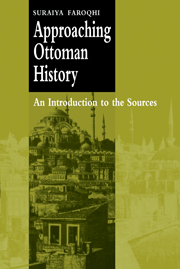Book contents
- Frontmatter
- Contents
- List of illustrations
- Acknowledgements
- 1 Introduction
- 2 Entering the field
- 3 Locating Ottoman sources
- 4 Rural life as reflected in archival sources: selected examples
- 5 European sources on Ottoman history: the travellers
- 6 On the rules of writing (and reading) Ottoman historical works
- 7 Perceptions of empire: viewing the Ottoman Empire through general histories
- 8 Conclusion
- References
- Index
7 - Perceptions of empire: viewing the Ottoman Empire through general histories
Published online by Cambridge University Press: 10 November 2009
- Frontmatter
- Contents
- List of illustrations
- Acknowledgements
- 1 Introduction
- 2 Entering the field
- 3 Locating Ottoman sources
- 4 Rural life as reflected in archival sources: selected examples
- 5 European sources on Ottoman history: the travellers
- 6 On the rules of writing (and reading) Ottoman historical works
- 7 Perceptions of empire: viewing the Ottoman Empire through general histories
- 8 Conclusion
- References
- Index
Summary
DELIMITING THE CORPUS OF TEXTS
This chapter is certainly not meant to be a comprehensive and systematic discussion of the manner in which the Ottoman Empire has been perceived in the course of time. Such a topic could easily fill a volume all by itself. More modestly, we will limit ourselves to books written during a relatively short timespan, roughly speaking, the last forty-five years. Moreover, the plot does not really thicken until after 1970. At this time Ottoman studies seem to have matured as a discipline, and at least a few Ottomanists began to think they might have something to contribute to the understanding of world history.
Since we are here concerned with the history of Ottoman historywriting, the relevant works have been discussed for the most part in the order of their appearance. However, to avoid losing sight of thematic connections among our texts, a grouping by major topics intersects with the chronological order. In the majority of cases, the first edition has been taken as the basis for classification. But when a later edition has been much amended, in fairness to the author this later text has usually been preferred. Due to the roughly chronological arrangement, we can conveniently highlight the dependence of a given author on his/her predecessors.
In order to delimit a corpus of texts indicating the development of our field, we will concentrate on general works, both single and multivolume. The period of Ottoman history discussed in the publications to be selected for analysis should be at least a century long.
- Type
- Chapter
- Information
- Approaching Ottoman HistoryAn Introduction to the Sources, pp. 174 - 203Publisher: Cambridge University PressPrint publication year: 1999

